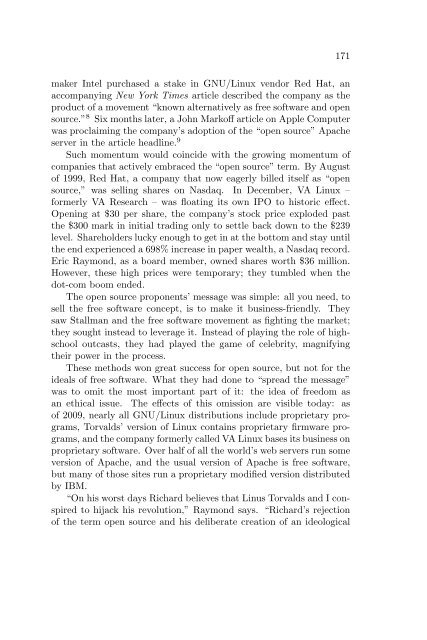Create successful ePaper yourself
Turn your PDF publications into a flip-book with our unique Google optimized e-Paper software.
171<br />
maker Intel purchased a stake in GNU/Linux vendor Red Hat, an<br />
accompanying New York Times article described the company as the<br />
product of a movement “known alternatively as free software and open<br />
source.” 8 Six months later, a John Markoff article on Apple Computer<br />
was proclaiming the company’s adoption of the “open source” Apache<br />
server in the article headline. 9<br />
Such momentum would coincide with the growing momentum of<br />
companies that actively embraced the “open source” term. By August<br />
of 1999, Red Hat, a company that now eagerly billed itself as “open<br />
source,” was selling shares on Nasdaq. In December, VA Linux –<br />
formerly VA Research – was floating its own IPO to historic effect.<br />
Opening at $30 per share, the company’s stock price exploded past<br />
the $300 mark in initial trading only to settle back down to the $239<br />
level. Shareholders lucky enough to get in at the bottom and stay until<br />
the end experienced a 698% increase in paper wealth, a Nasdaq record.<br />
Eric Raymond, as a board member, owned shares worth $36 million.<br />
However, these high prices were temporary; they tumbled when the<br />
dot-com boom ended.<br />
The open source proponents’ message was simple: all you need, to<br />
sell the free software concept, is to make it business-friendly. They<br />
saw Stallman and the free software movement as fighting the market;<br />
they sought instead to leverage it. Instead of playing the role of highschool<br />
outcasts, they had played the game of celebrity, magnifying<br />
their power in the process.<br />
These methods won great success for open source, but not for the<br />
ideals of free software. What they had done to “spread the message”<br />
was to omit the most important part of it: the idea of freedom as<br />
an ethical issue. The effects of this omission are visible today: as<br />
of 2009, nearly all GNU/Linux distributions include proprietary programs,<br />
Torvalds’ version of Linux contains proprietary firmware programs,<br />
and the company formerly called VA Linux bases its business on<br />
proprietary software. Over half of all the world’s web servers run some<br />
version of Apache, and the usual version of Apache is free software,<br />
but many of those sites run a proprietary modified version distributed<br />
by IBM.<br />
“On his worst days Richard believes that Linus Torvalds and I conspired<br />
to hijack his revolution,” Raymond says. “Richard’s rejection<br />
of the term open source and his deliberate creation of an ideological


